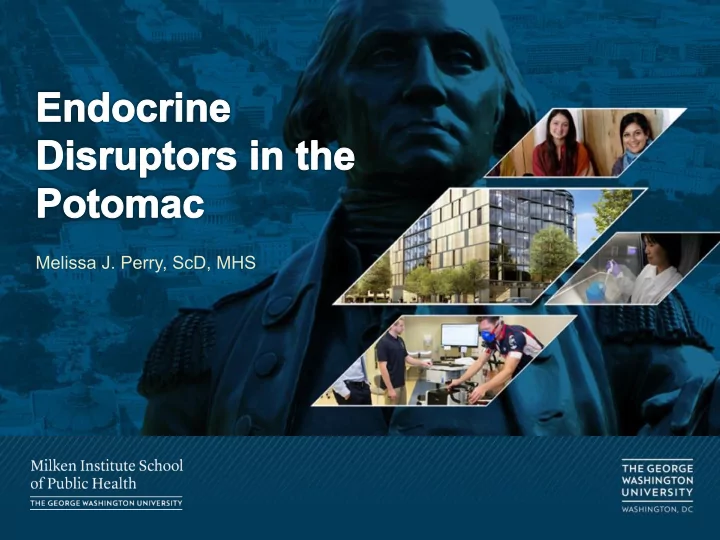

Melissa J. Perry, ScD, MHS
Chemicals in the Environment
Potomac River Watershed • Potomac is a sub-watershed of the Chesapeake Bay • Encompasses parts of VA, MD, WV, PA and all of DC
The Potomac river supplies 75% of the Potomac River Basin’s 6.5 million residents with their drinking water.
Intersex Bass in the Potomac • 2003: High numbers of intersex small mouth bass were observed in the Potomac • Male bass found to In 2005, USGS, FWS set out to have immature investigate the potential causes oocytes in testes
Water samples and bass specimens were collected at points upstream and downstream of three wastewater treatment plants in the Potomac watershed
What did they find? • Wastewater chemicals were highest downstream of the treatment plant • Pesticides were found in all water samples • Presence of endocrine disruptors
Hormone ¡Disrup-on ¡
Endocrine System • Hormone Signaling • Growth and Development • Puberty • Reproduction
Estrogen and DES Estradiol Diethylsilbesterol (Natural) (Synthetic)
Possible Hormone Disruption Effects of Pesticides • Sex steroid receptor • Sex steroid synthesis • Hypothalamus-pituitary-endocrine organ feedback mechanisms
Role of Endocrine Disruptors and Reproductive health Male Developmental reproductive anomalies (cryptorchidism, hypospadias) Falling sperm counts; infertility Testicular and prostate cancer Female Breast Cancer, Endometrial Cancer Endometriosis Infertility, menstrual cycle disturbances, early menopause
Europe North America Other
Prior Epidemiologic Studies Exposures Organochlorines Organophosphates Pyrethroid Pesticides Health Endpoints Male and Female Hormones Sperm abnormalities
Chromosomes in Human Sperm
Environmental Exposure to Polychlorinated Biphenyls and p,p ´-DDE and Sperm Sex-Chromosome Disomy Megan E. McAuliffe, 1 Paige L. Williams, 2 Susan A. Korrick, 1,3 Larisa M. Altshul, 1,4 and Melissa J. Perry 1,5 ¡ 1 Department of Environmental Health, and 2 Department of Biostatistics, Harvard School of Public Health, Boston, Massachusetts, USA; 3 Channing Laboratory, Department of Medicine, Brigham and Women’s Hospital, Harvard Medical School, Boston, Massachusetts, USA; 4 Environmental Health and Engineering Inc., Needham, Massachusetts, USA; 5 Department of Environmental and Occupational Health, George Washington University School of Public Health and Health Services, Washington, DC, USA Reproductive Toxicology 23 (2007) 113–118 ¡ Short communication ¡ Environmental pyrethroid and organophosphorus insecticide exposures and sperm concentration /'. a , ∗ , Scott A. Venners b , Dana B. Barr c , Xiping Xu b Melissa J. Perry ¡ a Department of Environmental Health, Harvard School of Public Health, Boston, MA 02115, USA b Department of Epidemiology, University of Illinois, Chicago, IL, USA c National Center for Environmental Health, Centers for Disease Control and Prevention, Atlanta, GA, USA Environmental exposure to pyrethroids and sperm sex chromosome disomy: a cross-sectional study Heather A Young 1 , John D Meeker2, Sheena E Martenies3, Zaida I Figueroa3, Dana Boyd Barr4 and Melissa J Perry3*
Study of land use/ Soil type related to Atrazine levels Urban Agriculture Forest Water
Maryland Grower survey of pesticide attitudes and changes to the worker protection standard • Low response rate • Variability in pesticide knowledge • Higher knowledge associated with higher receptivity to WPS changes
What can be done?
Farm Pesticide Use
Emergent Themes from Focus Groups with Farmers • Farm Sustainability • Time and Stress • Speculation or Resignation About Pesticide Health Impacts
LABEL REQUIREMENTS
EXPOSURE SIMULATION
Face ¡and ¡Neck ¡
Back
Lock and Load Method
After Lock and Load
PERSONAL PROTECTIVE EQUIPMENT
Pesticide Number Used No Gloves Goggle Boots Apron Cover- Gas Used All Applying Required alls Mask Required PPE PPE %(n) % % % % % % % % dicamba 46.4(102) 56.9 42.2 9.8 -- -- -- -- 8.8 atrazine 31.8(70) 38.6 57.1 18.6 24.3 -- -- -- 8.6 cyanazine 18.2(40) 47.5 50.0 20.0 20.0 5.0 -- -- 2.5 chlopyrifos 12.3(27) 66.7 25.9 7.4 22.2 0 -- -- 0 metolachlor 11.4(25) 44.0 56.0 -- -- -- -- -- 56.0 terbufos 5.0(11) 72.7 27.3 0 9.1 0 0 0 0
Farm Pesticides Outcomes of a Randomized Controlled Intervention to Reduce Risks ¡ Melissa J. Perry, ScD, MHS, Peter M. Layde, MD, MSc
Summary of Project Findings • Increased knowledge, risk perception, intentions • Increased PPE use and reduced total number of pesticides used • No evidence of decrease in exposure
Other Critical Needs Determine the extent of neonicotinoid use in Potomac River Valley Water and soil monitoring Biomonitoring of neonicotinoids
Recommend
More recommend